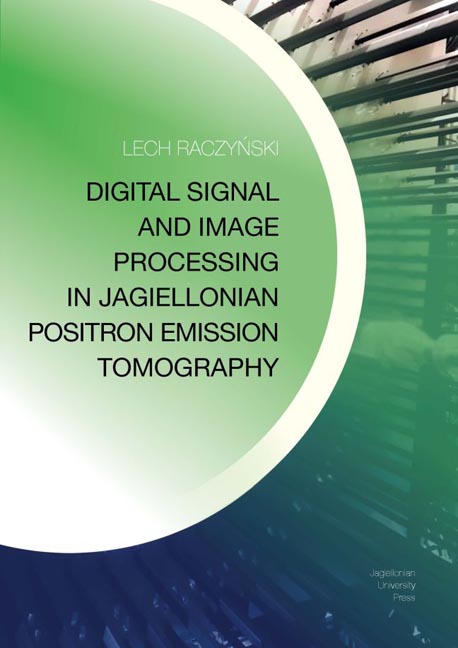Book contents
- Frontmatter
- Dedication
- Acknowledgements
- Contents
- Abbreviations
- Preface
- 1 Introduction
- 2 Positron Emission Tomography
- 3 Algorithmic background
- 4 Low-level data processing in Jagiellonian PET
- 5 High-level data processing in Jagiellonian PET
- 6 Results
- 7 Conclusions and summary
- Appendix
- References
- Miscellaneous Endmatter
7 - Conclusions and summary
Published online by Cambridge University Press: 13 October 2023
- Frontmatter
- Dedication
- Acknowledgements
- Contents
- Abbreviations
- Preface
- 1 Introduction
- 2 Positron Emission Tomography
- 3 Algorithmic background
- 4 Low-level data processing in Jagiellonian PET
- 5 High-level data processing in Jagiellonian PET
- 6 Results
- 7 Conclusions and summary
- Appendix
- References
- Miscellaneous Endmatter
Summary
The J-PET collaboration brings together scientists from different disciplines in order to develop a more affordable whole-body PET scanner. The application of the plastic scintillators entails the desing of unique detector geometry, dedicated electronics and reconstruction algorithms. Studies presented in this dissertation cover the analysis of the data processing in the J-PET scanner.
The operational principles of the J-PET scanner are similar to stateof- the-art PET detectors, except that the extremely precise time information is of paramount importance. In the J-PET, the time resolution influences not only the uncertainty of position reconstruction along the LOR, as in case of the conventional PET systems, but also has an impact on the uncertainty of position reconstruction along the scintillator strip. Therefore, the J-PET detector requires a development of novel methods at each step of data processing. The problem of data processing has been split into two separate parts in order to distinguish the low-level signal recovery and reconstruction from the high-level image processing. The goal of the low-level data processing is an evaluation of the information about each event of positron-electron annihilation based on the raw signals acquired during the PET examination. This information includes the estimated values of position and time of annihilation and deposited energy by two γ photons in the scintillators. In the next stage, denoted in this work as high-level data processing, the list of reconstructed events of positron-electron annihilations is subjected to further analysis with the primary goal of estimating the radioactive tracer distribution after injection into the patient’s body. Main achievements related to both stages of data processing in the J-PET tomography are shortly summarized in the next two sections.
Summary of low-level data processing
In this dissertation a novel scheme of signal recovery in plastic scintillators in the J-PET scanner was introduced. The idea of signal recovery is based on the Tikhonov regularization theory, which uses the training data set of signals. The compact representation of these signals was pro vided by the PCA decomposition. One of the most important aspects of this part of research is the statistical analysis of the error level of recovered signals.
- Type
- Chapter
- Information
- Publisher: Jagiellonian University PressPrint publication year: 2021



